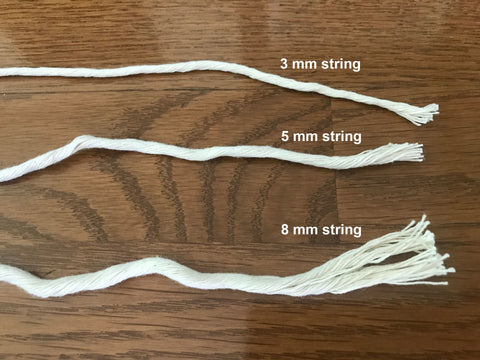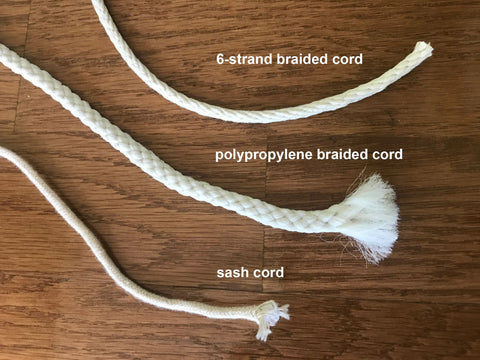What is the difference between macrame cord, macrame rope, and macrame string?

Recently in our Macrame Movement group on Facebook, a member asked, "What is the difference between macrame cord, macrame rope, and macrame string?" I wondered the same thing when I first started, so I'll explain the way I think about it here, as best as I can.
Macrame String is the soft, single twist string that really launched Niroma Studio as you know it today. It is the product I had manufactured for my own use, to create my own macrame wall hangings because I could not find it anywhere in the U.S. at the time. And it's what I think so many people have grown to love because of its softness and the fine fringe it creates.

I offer it in 3 mm, 5 mm and 7 mm natural cotton, and my Supersoft line is also single twist string.
**A quick note on sizing*** The measurements I give are after the string has been cut and has had a chance to expand. String expands more than rope or cord since it untwists easily so the actual diameter could potential vary 1 to 1.5 mm from when it's tightly wound around the tube, to after it's been cut and has had a chance to breathe. Other retailers may label differently, so keep that in mind.
I often get asked, "What is the best macrame string for beginners," and I always recommend the 5 mm natural cotton string. It's the perfect size to make a nice medium sized wall hanging, so it works up faster than the 3 mm, and it has a nice medium tight twist to it, so it can be carefully unknotted and reknotted a few times before losing its integrity as long as you're mindful. And of course, being easy on the hands really helps keep you going!
Macrame Rope is usually 3-strand rope (sometimes called 3-ply) where the strands are twisted around each other. I've seen it in 4 strands, but conventional rope tends to be 3-strand. Macrame rope is generally stronger than macrame string, and when you untwist it, it gives you that fun, wavy fringe, so it is great for adding texture to your work.

Because it is stronger, I tend to use it for furniture or pieces that will need to bear significant weight. Macrame rope also expands after it's cut, and depending on where you live, how much humidity you have, etc...it may even expand up to 1 mm.
Macrame Cord is usually a 6 strand (or more) braided cord, or what I believe was most commonly used for macrame in the '70s and early '80s when cotton string wasn't really 'the thing' to use. The very, very tightly wound cotton macrame cord is also called "sash cord." Sash cord is a bit stiff to use, and very difficult to unravel, but it is extremely strong, so it's good for weight bearing pieces and if you're looking to add lots of structure to your work. Macrame cord, in my experience, is the toughest on the hands, but when you want a certain look or functionality, no pain no gain!

Then there is polypropylene (or polyolefin) macrame cord, some of you might know one branded version as Bonnie Craft Cord, which is great for outdoor use as it will not mold as quickly as cotton. The fringe will be "frizzy" so that's just something to keep in mind.
********
Often, you'll see all three terms being used in listings even when referring to a single product. Shops, including myself, will often title our products on Amazon or Etsy, "Natural cotton macrame cord, macrame string, macrame rope," and that is so whichever term you search, the product will come up.
So there you have it, the low down on Macrame Rope, Macrame String, Macrame Cord terminology! If you have any more questions, please leave them in the comments below.


